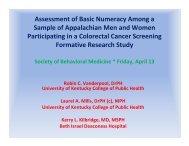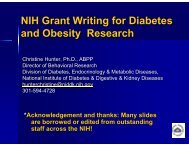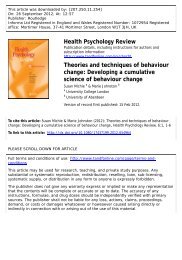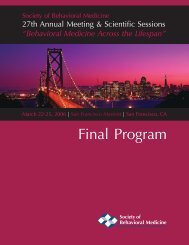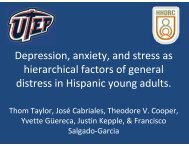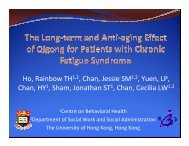Protective Buffering among Couples Coping with Cancer
Protective Buffering among Couples Coping with Cancer
Protective Buffering among Couples Coping with Cancer
- No tags were found...
Create successful ePaper yourself
Turn your PDF publications into a flip-book with our unique Google optimized e-Paper software.
PROTECTIVE BUFFERING AMONGCOUPLES COPING WITH CANCER:Motivations and Consequences
Relationship-focused coping• <strong>Protective</strong> buffering (PB)(Coyne & Smith, 1991)
<strong>Protective</strong> buffering as appliedto cancer (Hagedoorn et al., 2000)– hiding one’s concerns– denying one’s worries– concealing discouraging information– preventing the partner from thinking aboutthe cancer– yielding in order to avoid disagreement
What are the consequences ofprotective buffering (PB)?
DyadACTORPARTNER
Intrapersonal effectsACTORPARTNER
Interpersonal effectsACTORPARTNER
Why buffer?• Motivations– Other-protective• To protect one’s partner from distress– Self-protective• To protect oneself from distress
Aim• Examine affective consequences ofbuffering and motivations for such– Among hematopoietic stem cell transplantsurvivors and their spousal caregivers
Patient sequelaeMEDICALinfectiongraft-versus-host diseasepulmonary complicationsinfertilityrelapsesecondary malignancymortalityPSYCHOSOCIALdepressionanxietysexual dysfunctioncognitive impairmentoccupational disability
POMS anxiety x time and role1.61.4PatientCaregiver1.2Anxiety1.00.80.60.4pre-tx 6 mos 1 yr 2 yrsTimeLanger et al., 2003, Psycho-Oncology
Participants and procedure• 94 hematopoietic stem cell transplantsurvivors and their caregivers• Self-report assessments– <strong>Protective</strong> <strong>Buffering</strong>– Center for Epidemiologic Studies DepressionScale (CESD)
<strong>Protective</strong> <strong>Buffering</strong> Scale(Suls et al., 1997)– Denied or hid my anger– Denied or hid my worries– Avoided disagreeing <strong>with</strong> my partner– Gave in more during arguments <strong>with</strong> mypartner– Acted more positive than I felt– Avoided talking about things– Withheld potentially upsetting information
<strong>Protective</strong> <strong>Buffering</strong> Scale:Motivations to protect (Trost, 2005)• In doing these things…– To what extent have you wanted to protectyour partner from feeling bad or distressed?– To what extent have you wanted to protectyourself from feeling bad or distressed?
Received buffering– Denied or hid my anger– Denied or hid my worries– Avoided disagreeing <strong>with</strong> my partner– Gave in more during arguments <strong>with</strong> mypartner– Acted more positive than I felt– Avoided talking about things– Withheld potentially upsetting information
Pre-transplant sample characteristics (n = 94 dyads)Age, M (SD)Age, rangeGender, % femaleEthnicity, % HispanicRace, % CaucasianEducation, % collegeTotal income, % $60k+Marital status, % marriedYears in relationship, M (SD)Length of relationship, rangePatient54 (11)24-783029265------------Caregiver52 (12)24-787169262679622 (15)5 mos – 53 yrs
Patient clinical characteristicsRegimen intensity, %MyeloablativeNon-myeloablativeDiagnosis, %Acute LeukemiaMyelodysplasiaChronic LeukemiaLymphomaMultiple MyelomaOther633748308527
Actor Partner Interdependence Model(Kenny, Kashy & Cook, 2006)• Dependent variable– Depression (CESD)• Predictor– <strong>Buffering</strong>– Received buffering– Motivation to protect self– Motivation to protect other
Actor Partner Interdependence ModelMain effect of actorIntrapersonalEffect of actor’s behavior onactorMain effect of partnerInterpersonalEffect of partner’s behavioron actor
<strong>Buffering</strong>• Main effect of actor (p < .001)– The more participants buffered theirpartner, the higher their own depression
Received buffering• Main effect of actor (p < .001)– The more participants felt buffered,the higher their own depression
Motivation to protect self• Main effect of actor– The more participants buffered to protectthemselves, the higher their own depression(p = .024)• Actor x role interaction (p = .036)
Depression x actor motive to protect self and roleDepression (CESD)181716151413121110Low actor motive to protect selfHigh actor motive to protect selfPatientRoleCaregiverPatients highly motivated to protect themselves were more depressed than patientsless motivated to protect themselves.
Motivation to protect other• Main effect of partner– The more an individual’s partner bufferedhim/her for altruistic reasons, the higher theindividual’s depression (p = .044)• Partner x role interaction (p = .033)
Depression x partner motive to protect other and role1716Low partner motive to protect otherHigh partner motive to protect otherDepression (CESD)151413121110PatientRoleCaregiverCaregivers whose patients were highly motivated to protect them were more depressedthan caregivers whose patients were less motivated to protect them.
Conclusions• <strong>Buffering</strong> is deleterious• <strong>Buffering</strong> enacted by patients mayparadoxically hurt the very object oftheir protection– Themselves– Their partner
Limitations• Associational study• Observational and experimentaldesigns needed
Implications• Self-protection – avoidant coping• Is buffering amenable to intervention– <strong>Couples</strong>-based coping training(Baucom et al., 2009; Porter et al., 2009; Scott et al., 2004)• Provide opportunities to express



